Film infrared underfloor heating: system overview and installation technology
Comfortable temperature in the house is one of the main components of the concept of "comfort". Indeed, you must admit, no matter how beautiful the decoration of the walls is, and no matter how comfortable the furniture is, if the house is cold, you cannot fully rest and relax here. Not hoping for the uninterrupted operation of utilities, more and more of our compatriots are installing alternative sources of heat in their apartments. The most popular of them are all kinds of warm floors. Unfortunately, the installation of water or electric floor heating requires large-scale concrete work. What to do if redecorating in an apartment or a house is already over, but somehow they forgot to install a “warm floor”. The only way out of such an unpleasant situation can be an infrared warm floor.
Content
What is infrared heating and how does it work?
The film warm floor is two layers of a dense polymer, between which there is a heating element - a carbon nanostructure with unique properties. Carbon atoms formed into a hexagonal lattice several nanometers in size give the material the ability to emit in the far infrared spectrum. Infrared radiation is a part of the light spectrum with a wavelength of 5-20 microns that is invisible to the human eye. Such radiation is recognized not only harmless, but even beneficial to human health. Often this type of radiation is used in surgery, dentistry and sports medicine.
Infrared film floor heating consists of the following elements. Strips of carbon material with a width of about 1.5 cm are interconnected using copper busbars with a silver coating, which conduct electric current. The heating element is laminated on both sides with a dense polymer that does not inhibit infrared radiation and provides excellent protection against moisture, breakdowns and fire.
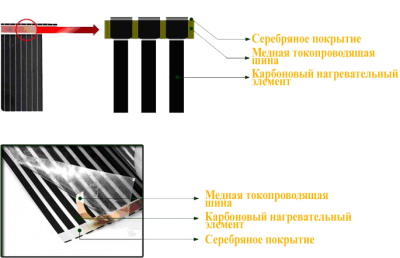
Advantages of the infrared system over other options for underfloor heating:
- This type of underfloor heating is very easy to install. It does not need to be covered with a concrete screed, which will allow you to lay it at any time, even when the repair is completely completed.
- Film underfloor heating has no restrictions on the choice of finishing flooring. It can be used under a laminate, parquet, carpet, ceramic tiles and any other decorative coating.
- The film thickness is usually 0.2-0.4 mm. When using it, the floor level practically does not rise, which allows you to do without steps and thresholds when you decide to arrange a warm floor in only one room.
- Low inertia allows the film to quickly heat up and stop heating just as quickly. So, you do not have to specifically monitor the thermometer: they froze - turned on, warmed up - turned off.
- Infrared radiation warms the room evenly and does not create a temperature difference from floor to ceiling.
- The film can be used in rooms involving a significant load on the finish, such as gyms, offices, public buildings.
- Thanks to the special design of the heating element, installing an infrared warm floor helps to save a lot. 25-30% percent less energy is spent on such heating.
- It is easily connected to the smart home system.
- Such a heating film practically does not create an electromagnetic field that adversely affects human health.
It is also important to note that not only the installation, but also the dismantling of the system is notable for its ease. If necessary, you can take it with you when moving.
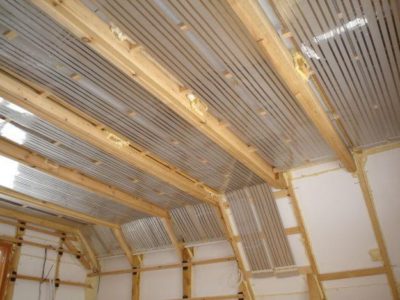
Specifications and area of use
If you have already decided to use infrared floor heating for heating, the technical specifications below will help you accurately calculate the amount of material needed and the upcoming heating costs:
- Width - from 0.5 to 1 m;
- Roll length - 50 m;
- Sheet thickness - from 0.23 to 0.47 mm;
- Power consumption of one m2 films - 25-35 W / h;
- The temperature on the surface of the film is 33 ° C.
It should be remembered that in the case of using infrared thermal film as the main source of heat, it should cover at least 70% of the floor surface. Such heating is not recommended in areas with harsh climates. In these regions, infrared heating can only be used as an additional or emergency. If there is an accident in the central heating system or the heating season has not yet arrived, and it is already cold outside, the installation of a warm film floor will not let you freeze.

You can cut thermal film only in specially marked places, take this into account when calculating the required amount of material. As a rule, the distance from one place of a possible cut to another is about 25 cm. In order not to buy too much, check the details with the seller.
In addition, infrared heating can be used not only in the house, but also in most household buildings, where it is difficult to bring in central heating. It can be a garage, a greenhouse or an animal shed. In severe frosts, the use of thermal film will help to prevent freezing of the pipeline or icing on the porch.
System installation and connection technology
As a rule, sellers of a film heat-insulated floor recommend to entrust its installation to specialists. In this case, you will receive a guarantee for the work performed for about 1 year. But the services of the masters are not cheap, and there is nothing complicated in this work.
Even if you are completely “not friends” with electricity, you can lay the film yourself, and charge the electrician only with its connection to the network:
- First you need to determine the location of the thermostat and install it.
- Clean the floor of debris and dust. Installation of a film underfloor heating should be done on a dry, clean and durable coating.
- If the rough flooring is wet, it is necessary to waterproof the thermal film. This can be done using a plastic film with a thickness of at least 50 microns.
- The next layer should be thermal insulation based on polypropylene or metallized lavsan film. The use of heat reflectors based on aluminum foil is not allowed.
- Now you need to cut the IPO into strips of the required length. When working in a large room, it should be borne in mind that the length of one strip should not exceed 10 m. Step away from each wall 20-30 cm and spread the film on the floor so that the copper busbars are at the bottom and fasten with adhesive tape. At this stage of work, special care is necessary - do not step on the film and do not allow the instruments to fall.
It is important to note that overlapping one IPO sheet on another is prohibited. This can lead to premature exit of their system.
If you still decide to use the services of an electrician, it's time to call him for help. If your choice is to do everything yourself, use the following algorithm for connecting the floor to electricity:
- First you need to strip the end of the wire (8-10 mm) and insert it into the shank of the contact clamp.
- Then install the clamp with the wire on the IPO so that one side is located on the copper bus and the other inside the IPO.
- Insulate the cut-off lines of the bus and the connection points with pieces of vinyl-mastic tape.
- When all ends of the sheets of thermal film are connected, it is necessary to measure the electrical resistance of the circuit at those ends of the wires that will be connected to the thermostat.
Using the formula W = V2 / R, where R is the resistance and V is the voltage in the mains, calculate the load and compare it with the maximum allowable for your model of thermostat. If the resulting figure is at least 20% less than that indicated on the thermostat, you can proceed to connect it. - Thermal film segments must be connected in parallel to the thermostat. Try to do this so that the bundles of wires can be hidden under the baseboard. To avoid damage to the wire, its individual sections can be hidden under thermal insulation.
- The thermostat kit should include a special temperature sensor that will monitor the heating of the floor covering. It must be installed under the carbon strip. If you plan to use soft material as a topcoat, install the sensor in the place with the least load.
- Now connect the thermostat to the mains and test the system. Over the entire surface of the floor there should be no sparking or heating of contacts. Set the desired heating temperature.
Installation of a film heat-insulated floor is completed. It remains only to lay the finishing decorative coating.
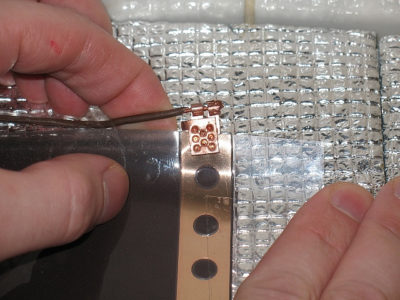
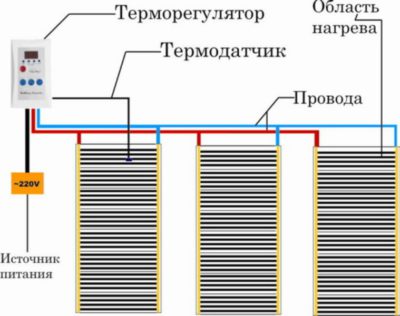
Laying Finish
Laying a carpet, parquet or laminate on an infrared film is carried out according to the standard scheme, but ceramic tile masonry has some features. The laminated film surface may interfere with the adhesion of the tile adhesive to the subfloor. To improve it, it is recommended to lay the mounting grid with a cell of up to 20 mm on the floor and fix it in those places where there is no IPO.
After completion of the tile laying, the adhesive solution should completely dry. This happens after 28-30 days. Turning on the heating system before this time is not recommended.
With the popularity of this material, more and more companies producing infrared warm floors appear. This material should be bought only from a trusted supplier who is not only able to maintain the issued guarantee, but is also ready to provide complete information about the intricacies of installation inherent in its products.


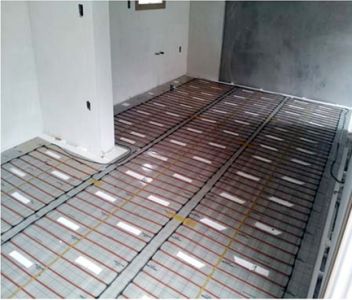

17 comments